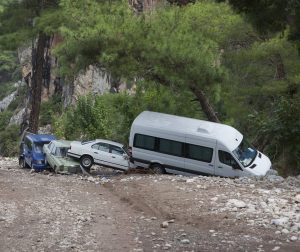When more than two cars are involved in an accident, it can seem difficult to figure out who’s at fault. However, if you have been involved in a multi-car accident, you only need to contact an experienced chain reaction attorney.
Get Car Accident Money knows exactly what to look for when determining fault in these types of accidents. Trust us to prove who was at fault and get you the compensation you deserve.

Defining Chain Reaction Car Accidents
A chain-reaction car crash is an accident where the force of one collision causes several others. These are serious and often lethal accidents that can cause life-threatening injuries, including:
- Brain injury
- Spinal cord injury
- Bone fracture
If you have been involved in a multi-vehicle accident, you don’t have to suffer alone. Contact Get Car Accident Money today for a free case consultation.
How a Chain Reaction Accident Occurs
Chain reaction accidents usually occur when one person is driving negligently, although it is possible for more than one person to be distracted and cause an accident.
Many of these accidents occur in the following way:
Vehicle A → Vehicle B → Vehicle C
Vehicles B and C are stopped at an intersection. Vehicle A approaches the intersection too quickly and can’t brake in time. Vehicle A collides into Vehicle B, who then collides into Vehicle C. The initial collision begins the chain reaction accident.
Chain reaction car accidents typically occur in areas with dense traffic or where cars are close to each other, like traffic stops or intersections.
After a chain reaction accident, make sure you get insurance information from the other drivers. Next, obtain the contact information of witnesses and take photographs of any skid marks, vehicle debris, or property damage.
You may also contact the police for a police report of the accident, which can help establish fault if you decide to press charges. If you are injured, contact an attorney immediately; they’ll make sure to collect the relevant evidence to present in court.
Determining Fault in a Chain Reaction Car Accident
It’s common for one driver to be at fault in a chain-reaction car accident, but it is possible for several drivers to be held liable. Although chain reaction accidents may result from a single driver’s negligence, multiple drivers can also be at fault due to carelessness.
Because many people and vehicles are involved, litigating a personal injury lawsuit can be particularly challenging.
It makes sense to assign liability in cases where the driver admits they were the first to hit a car in a line of cars. However, the outcome is usually not so straightforward. Because multiple people are involved, there will likely be multiple stories or testimonies. Also, certain factors like bad weather, road construction or repair, or an unrelated collision can lead to car accidents.
The key to proving a party’s fault (whether an individual or a public department) is to prove their negligence. Examples of negligence that cause chain-reaction car accidents include:
- Failing to use brake lights or other signals
- Following too closely
- Speeding
- Texting or being distracted while behind the wheel
- A public department that fails to install or fix proper traffic signals or signs
- A public department that fails to clear the road of debris or construction materials
In most states, the jury will deliberate over all evidence and distribute fault among defendants. However, one of the defendants may allege that the plaintiff was negligent as well. In that case, the jury will assign the plaintiff a portion of the fault.